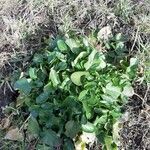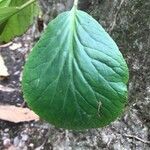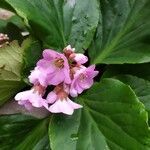Herbs perennial, 15-30 cm tall. Rhizomes thick, scaly. Leaves all basal; petiole 3-9 cm, sheathing base glabrous at margin; leaf blade narrowly to broadly obovate or elliptic, 5-12.5 × 3.5-9.5 cm, leathery, both surfaces glabrous and ± glandular pitted, base usually cuneate, rarely rounded, margin sinuate-dentate, apex obtuse. Inflorescence cymose, 3.5-13 cm, many flowered; branches and pedicels subsessile glandular. Hypanthium subsessile glandular. Sepals erect, obovate to broadly triangular-obovate, 3-4 × 2-4 mm, leathery, abaxially subsessile glandular, veins many, margin glabrous, apex obtuse or retuse. Petals purple, elliptic to broadly ovate, 7-8 × 4.6-5 mm, veins many, base narrowed into a claw ca. 1 mm, apex retuse. Stamens ca. 4.5 mm. Ovary ovoid, ca. 2.5 mm; styles 2, ca. 2.5 mm. Fl. May-Sep. 2n = 34.
More
An evergreen plant. It grows 50 cm high and spreads 70 cm wide. The rootstock is thick and woody. The stems are thick. The leaves are oval and deep green. There are teeth around the edge. The flowers are pink or red and have 5 petals. The flowers are in dense groups.
It is a temperate plant. It is best in a light to medium soil. It needs to be well-drained. It needs a cool sunny position. It is resistant to drought and frost. It grows between 1,100-1,800 m above sea level in western China. In Melbourne Botanical Gardens.
More
On shady north-facing rocks, stony slopes, rock streams and old moraines in the forest and alpine zones.










